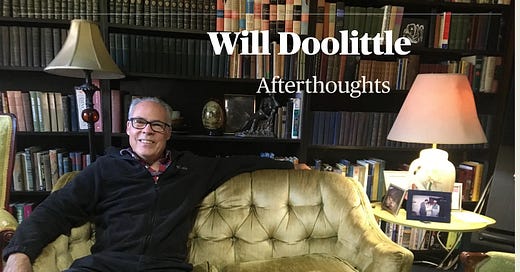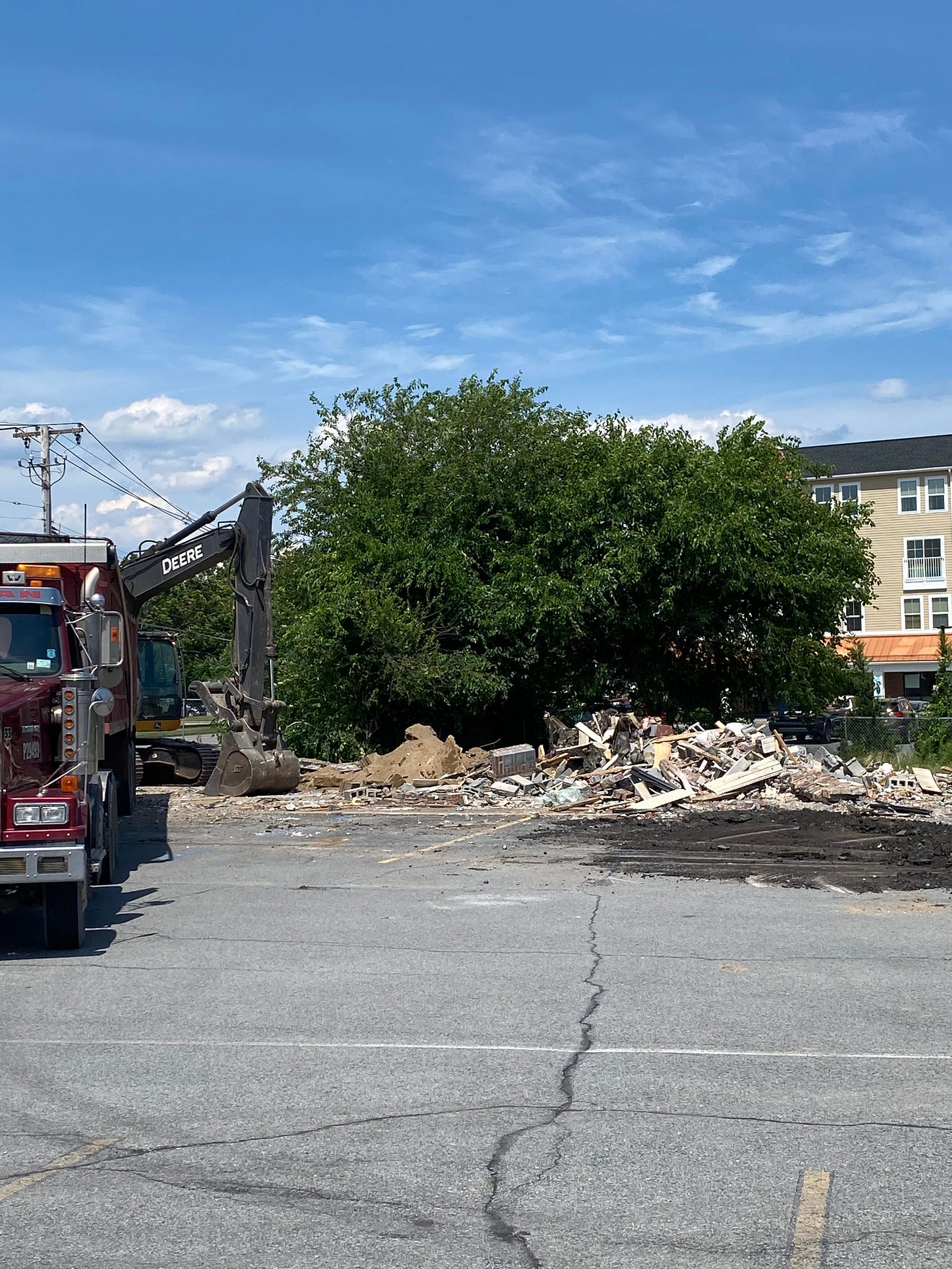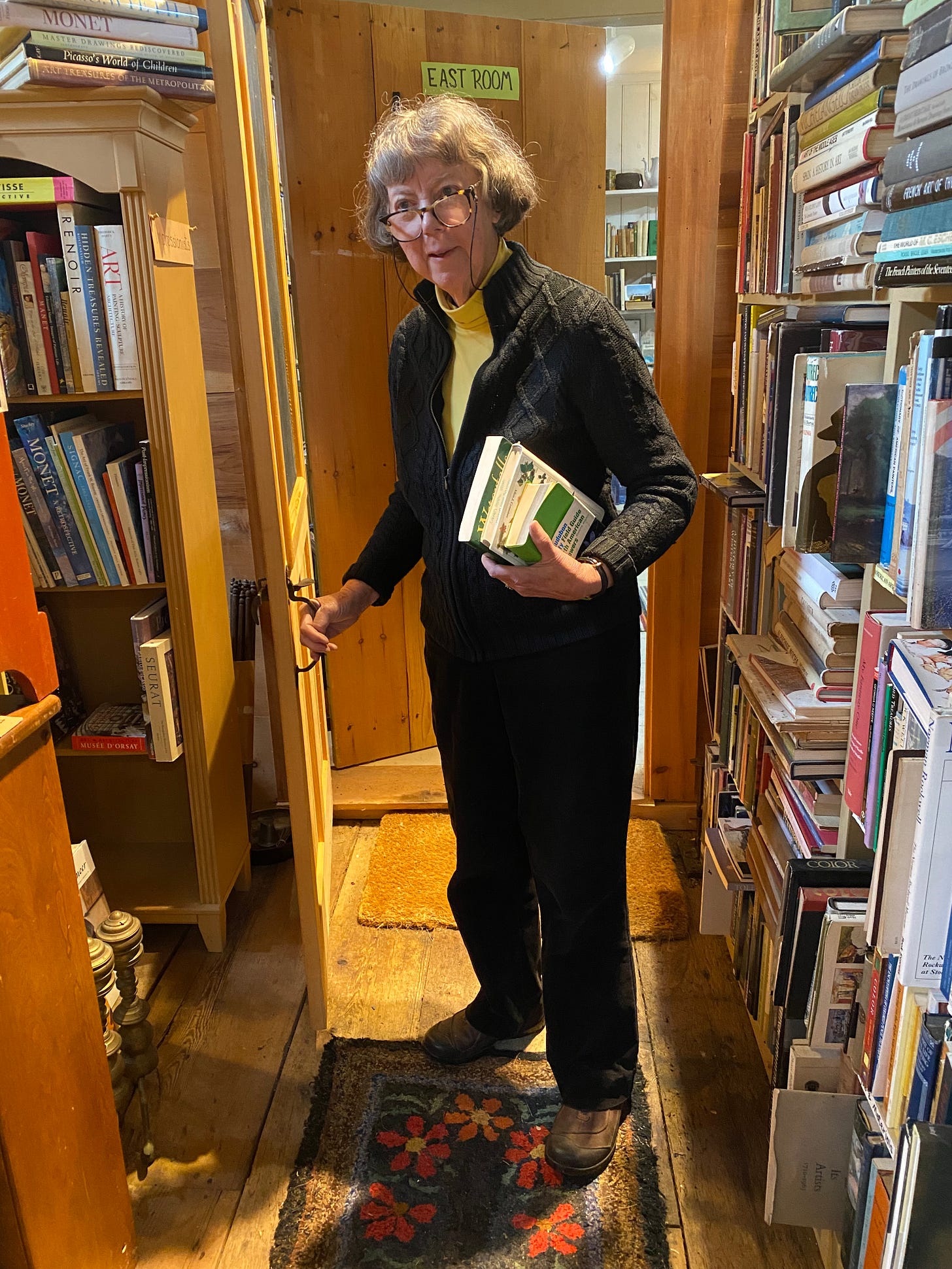A car wash fits in fine on Broad Street
We should let dogs in coffee shops
Please consider supporting The Front Page with a paid subscription: HERE
I’d like to add a shrug to the cacophony surrounding the demolition of Steve’s Place for a car wash.
Of the 300-plus comments that now follow a Chronicle Facebook photo of the rubble that used to be the restaurant, most are either steeped in nostalgia — “So sad, an end of an era. Was a mainstay in GF for years!!!!!” — or soaked in sarcasm — “It’s weird that there isn’t a car wash already nearby … “
If the nostalgic commenters mean it’s the end of an era of taking your family of four out for a sit-down dinner for under $50, then, yes, it probably is.
But the jibes about duplication of services — Adirondack Car Wash is half a block away — fall flat when you look around the neighborhood.
Up on the corner where Broad Street turns into Main Street and Thomas Street turns into Southwestern Avenue, CVS and Walgreen’s stand kitty-corner from each other, while Hannaford, with its busy pharmacy, stands on a third corner.
Locating next to a competitor isn’t necessarily bad for business, and the new Hoffman Car Wash will have a full-service tunnel (along with 15 self-serve vacuums), while Adirondack is self-service only.
Planning Boards aren’t charged with critiquing business plans or protecting existing businesses from competition. Commenters blaming the the board for allowing a second car wash on Broad Street are off-base. It was Christine Vamvalis-Haley, owner of Steve’s Place, who sold the lot to Hoffman Car Wash, and she had every right to do so.
The city’s Board of Public Safety recommended against the car wash, saying the traffic it generates could obstruct ambulances on their way to the hospital.
But a traffic study found more than enough room on the street to handle the turn-ins and -outs from a new car wash and said ambulances could go down the middle of the street, between lines of traffic, if necessary. On Friday afternoon, standing in Crandall Park, I watched an ambulance do exactly that on Glen Street, which, because of a crash on the Northway, was backed up with cars all the way into the city.
Steve’s Place was roomy for a diner-style restaurant, with a big parking lot, so it had at least the potential of being very busy. Few car wash customers park and wait — they either get in line or drive on, so it’s likely traffic at the new business won’t be greater than it was for the restaurant.
It’s the unappealing optics of a car wash that we dislike, but in this case, at least it fits in the neighborhood. The overarching problem is our attachment to and obsession with automobiles.
We drive everywhere. Glens Falls is a “walking district,” but many parents insist on driving their kids the three or four blocks to school.
We struggle to keep the city bus service viable, because everyone wants to drive, not ride.
We build our cars extra large, with entertainment systems and window shades and cup holders and super-padded, button-controlled seats.
We plan our communities to accommodate our cars, when it should be vice-versa. We’re not going to exclude car washes from commercial districts any more than we would exclude gas stations.
Automobiles are so interwoven into the patterns of our lives, it feels impossible in a place like Glens Falls to live normally without spending lots of time in your car.
We go into debt to buy bigger cars than we need — or pickup trucks we don’t need — and we keep them shiny, because impressing friends and neighbors is also an important function of our car.
The size of the national “car wash and auto detailing” market was $14.72 billion in 2022 and rising.
This new car wash will flourish. Traffic will continue to increase along the Exit 18 corridor. Peak times will lengthen until it’s jammed with automobiles for most of the day — a dazzling two-mile-long bumper-to-bumper backup of gleaming aluminum, going nowhere.
Dogs in coffee shops
Bella and I took a trip to Edinburgh six years ago. In addition to being a city in which many people walk, few people drive and the city buses are clean, timely, inexpensive and abundant, it’s a city where coffee shops and small eateries allow customers to bring in their dogs. This worked great, as far as I could see.
Why do we ban dogs from places where food is served? We certainly don’t do that in our houses. Is there any science behind the ban or is it tradition, based on a notion of cleanliness?
Apparently, the Department of Health has recently cracked down on our two downtown coffee shops — Kru and Spot — and both have had to tell customers, including Bella and me and Ringo, that dogs must stay out. This led to a standoff Friday, when the three of us were sitting at a sidewalk table at Spot, and Bella said she had to use the bathroom. I walked her in, and since I couldn’t leave Ringo by himself on the sidewalk, I brought him.
I was confronted by an employee as I stood outside the bathroom, waiting for Bella, but I refused to budge, and we went back outside after Bella came out.
When I went back in to order food, the employee confronted me again.
“You can’t bring the dog in here,” she said.
“I understand,” I said. “I was just bringing my wife to the bathroom.”
“You still can’t bring the dog in here,” she said.
“My wife has Alzheimer’s,” I said. “She won’t leave the house without the dog. We sit on the sidewalk, but she had to use the bathroom. I can’t leave the dog on the sidewalk. My wife will get lost if she comes in here by herself. She won’t remember to lock the bathroom door.”
“You can’t —“ she said.
“Are you going to push this?” I said. “Because if you are, I want to know your name and I want to speak to the manager.”
She threw up her hands, disappeared into the back, and, a few minutes later, another young woman came out from the kitchen.
“You can bring the dog in for your wife to use the bathroom,” she said. “Please don’t be angry at our employee. We have to follow Department of Health rules.”
“I wasn’t angry,” I said.
But I was angry. I could feel the anger twisting my face and tightening my voice as I spoke.
I’m willing to follow rules, including ones I disagree with. I understand the shop’s employees have to abide by state regulations, and I’m sure the person who confronted me had been told to make sure no dogs entered the shop that weren’t service dogs.
But there is a time and place for making exceptions out of kindness, which, in the end, the coffee shop did. So, despite the anger, I’m grateful.
Washington County is wonderful
We took a drive Saturday in Washington County, which gives me a chance to return to one of my favorite themes: how beautiful Washington County is. Its hills and fields present tableaus as you travel along its winding roads (pay attention!) that are unparalleled for scenic beauty, including in Vermont, whose scenery gets a lot more attention.
Here is a brief video I pulled off the road (Route 196, maybe) to take:
We continued into Hebron, to the 1786 Wilson Homestead, a bookstore promoted by the lovely, charming and smart proprietor, Sally Brillon, as “Nonfiction for the Curious.” She also has some fiction. Here is a photo of the shop’s entrance, a representation of the gates of paradise:

We chatted a bit with Brillon, whom we found deeper inside the shop, and who told us about leading the compilation in 1976 of “An Introduction to Historic Resources of Washington County,” with hundreds of photos of the county’s historic buildings. Here is Brillon in her lair:








Now I know why I haven't seen you ad Bella at KRU. In Europe dogs are allowed EVERYWHERE, and there is NEVER a bark! Why can't we petition our Common Council and get this rule changed??? So sorry to hear this...
Having guided two through this terrible disease, I feel so much of what it was like and I have now relegated to the dusty corners of my memory. Your journeys and writing describe the kindness and dignity required on the path you are one, thanks for that Will, and lucky you and Ringo that you have Bella to guide you as well .